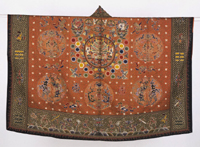Another Elder Story
Three years after I dreamed of the turtle gift from MJ (described in the blog of May 16), a small group of women, now all analysts, asked MJ to do a reading group, and when she agreed, we chose The Secret of the Golden Flower, a Taoist text translated from Chinese into German by Richard Wilhelm, a friend of Carl Jung. Wilhelm asked Jung to do the introduction. In fact, the manuscript was Jung’s introduction to alchemy. The rest of Jung’s life would be devoted to the study of both eastern and western alchemy.
Synchronistically, a Taoist art exhibit was coming to the Asian Art Museum in San Francisco, and MJ, also a docent at the museum (she was in her late 80’s), had been studying the objects and their history . Many of the objects had been “rediscovered” in recent years after having been stored for centuries. She offered to give our group a private tour as a way to begin our reading of the Taoist/Buddhist manuscript.
 |
| Daoist Priest’s Robe, c. 1850-1900 Chinese, from https://www.philamuseum.org/booklets/3_18_37_0.html |
I remember standing before an exhibit of Taoist priest robes as MJ described the priesthood, a later development in Taoism. Suddenly I was in another realm. As I examined the robes’ embroidered depictions of the universe, intricate stars and planets, sky and earth, animals and plants over their entirety, I remembered the dream I had had of the turtle. When I checked back to see when I had had the dream, it was three years to the day.
I have talked about some of my insights and learnings from the dream in the previous blog, but here I want to focus on a perspective I gained from this synchronistic experience: Sometimes things end as we have known them, but what is of value is not lost. A kind of distillation of what is essential is occurring, the nonessential falling away.
MJ explained that although Taoism disappeared from common practice for centuries in China (although it was kept alive in Taiwan), it has been seeded back into eastern and western culture. Witness the publishing of other Taoist manuscripts, and particularly the Tao de Ching.
Taoism, or The Way, begins with the “anterior heaven” of oneness, then separates into opposites and the interplay of yin and yang. In the holding of opposites and the chaos it creates, the new born child develops, psychologically and spiritually, —as well as the 10,000 things. Like Jung’s transcendent function, this results in another kind of wholeness, a “later heaven”.
Many of the values of this shamanic, nature-based philosophy, have sprouted in this eleventh hour as we realize the extent of our devaluing of nature. Taoism originated as a counterbalance to the rising conservative forces at the end of the Zhou Dynasty (700 BC-200 BC) which worked to accumulate power and suppress of women. In contrast, Taoism held sacred the holy mountains, streams, and female deities, a religion of the common people. One might wonder if its reappearance now is also a counterbalance to the conservative push of powerful men to control not only wealth but also women and the natural feminine world.
At the time of this writing, I realize how much Taoism has influenced me and my work in analytical psychology and in farming. The turtle dream presaged the importance Taoist concepts would have for me, its honoring the natural world, its feminine, nonhierarchical process, and shamanic substructure.
But I also wonder if the synchronicity reflects a parallel process of Jung’s work moving into the common culture. Jung’s The Red Book, the account of his own in-turning to learn to communicate with figures in the psyche, has been a huge success, many non-Jungians purchasing the very large and expensive volume. In fact, I see more excitement about analytical psychology outside the psychological community in the educated public than within it. Will analytical psychology be held in the collective to be seeded back into psychology sometime in the future?
As educated elder, MJ modeled the feminine holding of the humus of history in which seeds of the essential plant can take root again. Her wisdom shows brightest in her willingness face the chaos of the unknown. What version of this plant will grow this time? This is a time requiring surrender and the incubating warmth of our attentions from which creative initiative can germinate.
